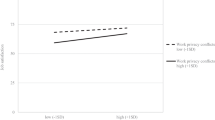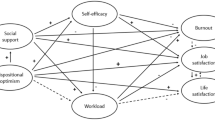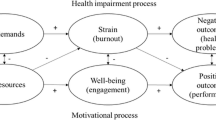Abstract
We examine the role of personal resources (hardiness) and personal vulnerability factors (external locus of control and helplessness) at work, among 430 teachers at private schools. Based on the Job Demands-Resources (JD-R) model and the conservation of resources theory, we parallel tested both motivational and health-impairment processes on the teachers’ individual outcomes. The JDR model’s motivational process was related to life satisfaction, and the health impairment process to perception of ill health. We hypothesize that hardiness will foster work engagement and that its role in the motivational process will be to mediate between job resources and work engagement. Then, we hypothesize that hardiness will prevent job burnout. Self-evaluations are expected to be activated by job burnout as an effect of its third dimension, inefficacy. We examine the mediational role of these self-evaluations between job burnout and ill health, and between job burnout and life satisfaction. The hypotheses are tested simultaneously using structured equation modelling. The results indicate that hardiness partially mediates the relationship between job resources and work engagement, and that hardiness reduces job burnout. Self-evaluations did not increase perception of ill health, but they did mediate the relationship between job burnout and life satisfaction. The findings show that hardiness plays the role of a personal resource in the motivational process and that it also has a preventive function against job burnout. Personal vulnerability factors, in the form of self-evaluations, were activated by job burnout, and their role was to significantly reduce life satisfaction. We discuss the implications of these findings.


Similar content being viewed by others
References
Abad, F. J., Olea, J., Ponsoda, V., & García, C. (2011). Medición en ciencias sociales y de la salud. Madrid: Síntesis.
Alarcon, G., Eschleman, K. J., & Bowling, N. A. (2009). Relationships between personality variables and burnout: A meta-analysis. Work and Stress, 23(3), 244–263. doi:https://doi.org/10.1080/02678370903282600.
Arbuckle, J. L. (2014). IBM® SPSS® AMOSTM™ 23 user’s guide. Crawfordville: Amos Development Corporation.
Bakker, A. B., & Bal, M. P. (2010). Weekly work engagement and performance: A study among starting teachers. Journal of Occupational and Organizational Psychology, 83, 189–206. https://doi.org/10.1348/096317909x402596.
Bakker, A. B., Demerouti, E., & Sanz-Vergel, A. I. (2014). Burnout and work engagement: The JD-R approach. Annual Review of Organizational Psychology and Organizational Behavior, 1, 389–411. https://doi.org/10.1146/annurev-orgpsych-031413-091235.
Bartone, P. (2015). Leader influences on resilience and adaptability in organizations. In U. Kumar (Ed.), The Routhledge international handbook of psychosocial resilience (pp. 93–111). New Delhi: Sage.
Benevides, A., Moreno-Jiménez, B., Garrosa, E., & González, J. (2002). La evaluación específica del síndrome de Burnout en psicólogos: el “Inventario de Burnout de psicólogos”. Clínica y Salud, 13, 257–283.
Betoret, F. D. (2009). Self-efficacy, school resources, job stressors and burnout among Spanish primary and secondary school teachers: A structural equation approach. Educational Psychology, 29, 45–68. https://doi.org/10.1080/01443410802459234.
Byrne, B. (1994). Burnout: Testing for the validity, replication, and invariance of causal structure across elementary, intermediate, and secondary teachers. American Educational Research Journal, 31(3), 645–673.
Cabañero Martínez, M. J., Richart, M., Cabrero, J., Orts, M., Reig, A., & Tosal, B. (2004). Fiabilidad y validez de la Escala de Satisfacción con la Vida de Diener en una muestra de mujeres embarazadas y puérperas. Psicothema, 27, 448–455.
Chen, S., Westman, M., & Hobfol, S. E. (2015). The commerce and crossover of resources: Resource conservation in the service of resilience. Stress and Health, 31(2), 95–105.
Cuenca, R., y O’Hara, J. (2006). El estrés de los maestros: percepción y realidad. Estudio de casos en Lima Metropolitana. Lima: Ministerio de Educación -DINFOCAD -PROEDUCA – GTZ.
De Stasio, S., Fiorilli, C., Benevene, P., Uusitalo-Malmivaara, L., & Di Chiacchio, C. (2017). Burnout in special needs teacher at kindergarten and primary school: Investigating the role of personal resources and work wellbeing. Psychology in the Schools, 54(5), 472–486.
Demerouti, E., Bakker, A. B., Nachreiner, F., & Schaufeli, W. B. (2001). The job demands-resources model of burnout. Journal of Applied Psychology, 86, 499–512. https://doi.org/10.1037/0021-9010.86.3.499.
Diener, E., Emmons, R. A., Larsen, R. J., & Griffin, S. (1985). The satisfaction with life scale. Journal of Personality Assessment, 49, 71–75. https://doi.org/10.1207/s15327752jpa4901_13.
Diestel, S., & Schmidt, K. H. (2010). Direct and interaction effects among the dimensions of the Maslach burnout inventory: Results from two German longitudinal samples. International Journal of Stress Management, 17(2), 159–180.
Ennis, N. E., Hobfoll, S. E., & Schröder, K. E. (2000). Money doesn’t talk, it swears: How economic stress and resistance resources impact inner-city women’s depressive mood. American Journal of Community Psychology, 28(2), 149–173.
Eschleman, K. J., Bowling, N. A., & Alarcon, G. M. (2010). A meta-analytic examination of hardiness. International Journal of Stress Management, 17, 277–307. https://doi.org/10.1037/a0020476.
Fernández, M. (2008). Burnout, autoeficacia y estrés en maestros peruanos: Tres estudios fácticos. Ciencia y Trabajo, 10(30), 120–125.
Garrosa, E., Moreno-Jiménez, B., Rodríguez-Muñoz, A., & Rodríguez Carvajal, R. (2011). Role stress and personal resources in nursing: A cross-sectional study on burnout and engagement. International Journal of Nursing Studies, 48(4), 479–489.
Hakanen, J. J., & Schaufeli, W. B. (2012). Do burnout and work engagement predict depressive symptoms and life satisfaction? A three-wave seven-year prospective study. Journal of Affective Disorders, 141, 415–424. https://doi.org/10.1016/j.jad.2012.02.043.
Hakanen, J., Bakker, A., & Schaufeli, W. (2006). Burnout and work engagement among teachers. Journal of School Psychology, 43, 495–513. https://doi.org/10.1016/j.jsp.2005.11.001.
Hobfoll, S. E. (2002). Social and psychological resources and adaptation. Review of General Psychology, 6, 307–324. https://doi.org/10.1037/1089-2680.6.4.307.
Hobfoll, S. E. (2010). Conservation of resource caravans and engaged settings. Journal of Occupational and Organizational Psychology, 84, 116–122.
Hobfoll, S. E. (2012). Conservation of resources theory: Its implication for stress, health, and resilience. In S. Folkman (Ed.), The Oxford handbook for stress, health, and coping (pp. 1–42). Oxford: Oxford Handbooks Online.
Hobfoll, S. E., Johnson, R. J., Ennis, N., & Jackson, A. P. (2003). Resource loss, resource gain, and emotional outcomes among inner city women. Journal of Personality and Social Psychology, 84, 632–643. https://doi.org/10.1037/0022-3514.84.3.632.
Hu, L. T., & Bentler, P. M. (1999). Cutoff criteria for fit indexes in covariance structure analysis: Conventional criteria versus new alternatives. Structural Equation Modeling, 6(1), 1–55. https://doi.org/10.1080/10705519909540118.
Jennings, P. A., & Greenberg, M. T. (2009). The prosocial classroom: Teacher social and emotional competence in relation to student and classroom outcomes. Review of Educational Research, 79, 491–525. https://doi.org/10.3102/0034654308325693.
Judge, T. A., Locke, E. A., Durham, C. C., & Kluger, A. N. (1998). Dispositional effects on job and life satisfaction: The role of core evaluations. Journal of Applied Psychology, 83, 17–34. https://doi.org/10.1037/0021-9010.83.1.17.
Keller, M. M., Chang, M.-L., Becker, E. S., Goetz, T., & Frenzel, A. C. (2014). Teachers’ emotional experiences and exhaustion as predictors of emotional labor in the classroom: An experience sampling study. Frontiers in Psychology, 5, 1442.
Klem, A. M., & Connell, J. P. (2004). Relationships matter: Linking teacher support to student engagement and achievement. Journal of School Health, 74, 262–273.
Kline, P. (2000). The handbook of psychological testing (2nd ed.). London: Routledge.
Kobasa, S. C. (1979). Stressful life events, personality, and health: An inquiry into hardiness. Journal of Personality and Social Psychology, 37(1), 1–11. https://doi.org/10.1037/0022-3514.37.1.1.
Kobasa, S. C., Maddi, S. R., & Kahn, S. (1982). Hardiness and health: A prospective study. Journal of Personality and Social Psychology, 42, 168–177. https://doi.org/10.1037/0022-3514.42.1.168.
Kokik, P., & Bell, P. (1994). Optimal winsorizing cutoffs for a stratified finite population estimator. Journal of Official Statistics, 10, 419–435.
Korunka, C., Kubicek, B., Schaufeli, W., & Hoonaker, P. (2009). Work engagement and burnout: Testing the robustness of the job demands-resources model. The Journal of Positive Psychology, 4(3), 243–255.
Lazarus, R.S., & Folkman, S. (1984). Stress, appraisal, and coping. New York: Springer Publishing Company, Inc.
Lee, R. T., & Ashforth, B. E. (1996). A meta-analytic examination of the correlates of the three dimensions of job burnout. Journal of Applied Psychology, 8, 123–133.
Levenson, H. (1973). Multidimensional locus of control in psychiatric patients. Journal of Consulting and Clinical Psychology, 41, 397–404. https://doi.org/10.1037/h0035357.
Lo Bue, S., Taverniers, J., Mylle, J., & Euwema, M. (2013). Hardiness promotes work engagement, prevents burnout, and moderates their relationship. Military Psychology, 25, 105–115. https://doi.org/10.1037/h0094952.
Lorente, L. S. (2008). Extension of the job demands-resources model in the prediction of burnout and engagement among teachers over time. Psicothema, 20, 354–360.
Maddi, S. (1997). Personal views survey II: A measure of dispositional hardiness. In C. P. Zalaquett & R. J. Wood (Eds.), Evaluating stress: A book of resources (pp. 293–309). Lanham: Scarecrow Press, Inc..
Maddi, S. R. (2006). Hardiness: The courage to grow from stresses. The Journal of Positive Psychology, 1, 160–168. https://doi.org/10.1080/17439760600619609.
Maslach, C. (1993). Burnout: A multidimensional perspective. In: W. Schaufeli, C. Maslach & T. Marek (Eds.), Professional burnout: Recent developments in theory and research (pp. 19–32). Washington, DC: Taylor & Francis.
Maslach, C., Schaufeli, W. B., & Leiter, M. P. (2001). Job burnout. Annual Review of Psychology, 52, 397–422. https://doi.org/10.1146/annurev.psych.52.1.397.
Melamed, S., Shirom, A., Toker, S., Berliner, S., & Shapira, I. (2006). Burnout and risk of cardiovascular disease: Evidence, possible causal paths, and promising research directions. Psychological Bulletin, 132, 327–353. https://doi.org/10.1037/0033-2909.132.3.327.
Minkov, M. (2009). Predictors of differences in subjective well-being across 97 nations. Cross-Cultural Research, 43, 152–179. https://doi.org/10.1177/1069397109332239.
Moreno-Jiménez, B., Garrosa, E., & González, J. (1999). La personalidad resistente, burnout y salud. Escritos de Psicología, 4, 64–77.
Moreno-Jiménez, B., Garrosa, E., & González, J. (2000). La evaluación del estrés y el burnout del profesorado: CBP-R. Revista de Psicología del Trabajo y de las Organizaciones, 16, 331–349.
Pavot, W., & Diener, E. (1993). Review of the satisfaction with life scale. Psychological Assessment, 5, 164–172.
Roorda, D. L., Koomen, H. M. Y., Spilt, J. L., & Oort, F. J. (2011). The influence of affective teacher-student relationships on students’ school engagement and achievement: A meta-analytic approach. Review of Educational Research, 81, 493–529. https://doi.org/10.3102/0034654311421793.
Schaufeli, W., & Bakker, A. (2003). The Utrecht work engagement scale. Unpublished manuscript. Utrecht University, The Netherlands. Retreived from www.schaufeli.com.
Schaufeli, W. B., & Bakker, A. B. (2004). Job demands, job resources, and their relationship with burnout and engagement: A multi-sample study. Journal of Organizational Behavior, 25, 293–315. https://doi.org/10.1002/job.248.
Schaufeli, W., & Taris, T. (2014). A critical review of the job demands-resources model: Implications for improving work and health. In G. Bauer & O. Hämmig (Eds.), Bridging occupational, organizational and public health: A transdisciplinary approach (pp. 43–67). Dordrecht: Springer.
Schaufeli, W. B., Salanova, M., González-Romá, V., & Bakker, A. B. (2002). The measurement of engagement and burnout: A two sample confirmatory factor analytic approach. Journal of Happiness Studies, 3, 71–92. https://doi.org/10.1023/a:1015630930326.
Schumm, J. A., Stines, L. R., Hobfoll, S. E., & Jackson, A. P. (2005). The double-barreled burden of child abuse and current stressful circumstances on adult women: The kindling effect of early traumatic experience. Journal of Traumatic Stress, 18(5), 467–476.
Shirom, A. (1989). Burnout in work organizations. In C. L. Cooper & I. T. Robertson (Eds.), International review of industrial and organizational psychology (pp. 25–48). New York: Wiley.
Sung-Mook, H. (1994). The relationship of satisfaction with life to personal characteristics. The Journal of Psychology, 128, 547–558. https://doi.org/10.1080/00223980.1994.9914912.
Van den Broeck, A., Vansteenkiste, M., De Witte, H., & Lens, W. (2008). Explaining the relationships between job characteristics, burnout, and engagement: The role of basic psychological need satisfaction. Work and Stress, 22, 277–294. https://doi.org/10.1080/02678370802393672.
van Mierlo, M. L., van Heugten, C. M., Post, M. W. M., de Kort, P. L. M., & Visser-Meily, J. M. A. (2015). Life satisfaction post stroke: The role of illness cognitions. Journal of Psychosomatic Research, 79, 137–142. https://doi.org/10.1016/j.jpsychores.2015.05.007.
Vink, J., Ouweneel, E., & Le Blanc, P. M. (2011). Psychological resources for engaged employees: Psychological Capital in the job Demands-Resources Model. Gedrag en Organisatie, 24(2), 101–120.
Xanthopoulou, D., Bakker, A. B., Demerouti, E., & Schaufeli, W. B. (2007). The role of personal resources in the job demands-resources model. International Journal of Stress Management, 14, 121–141. https://doi.org/10.1037/1072-5245.14.2.121.
Yslado, R., Núñez, L., & Norabuena, R. (2010). Diagnóstico y programa de intervención para el síndrome de burnout en profesores de educación primaria de distritos de Huaraz e Independencia. Revista IIPI, 13(1), 151–162.
Author information
Authors and Affiliations
Corresponding author
Ethics declarations
Conflict of Interest
The authors certify that there is no conflict of interest of any kind.
Ethical Approval
The present study followed the ethical standards of the 1964 Helsinki declaration and its later amendments or comparable ethical standards on all procedures regarding human participants.
Informed Consent
The headmasters or headmistresses of the participating schools, and, in turn, the teachers who took part, voluntarily gave their consent to take part in the study after the aims and objectives of the research project were made known to them.
Rights and permissions
About this article
Cite this article
Corso-de-Zúñiga, S., Moreno-Jiménez, B., Garrosa, E. et al. Personal resources and personal vulnerability factors at work: An application of the Job Demands-Resources model among teachers at private schools in Peru. Curr Psychol 39, 325–336 (2020). https://doi.org/10.1007/s12144-017-9766-6
Published:
Issue Date:
DOI: https://doi.org/10.1007/s12144-017-9766-6




